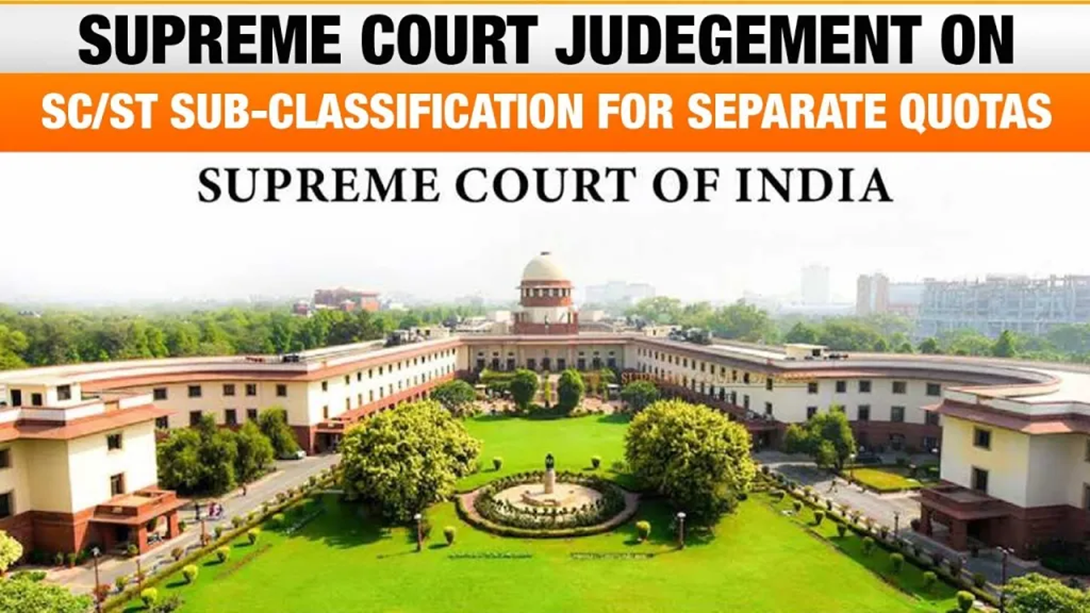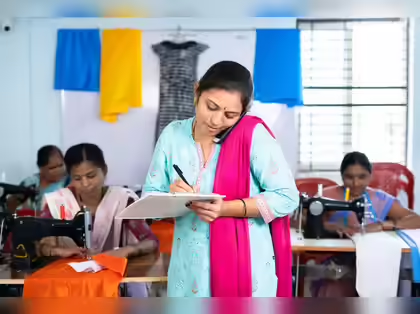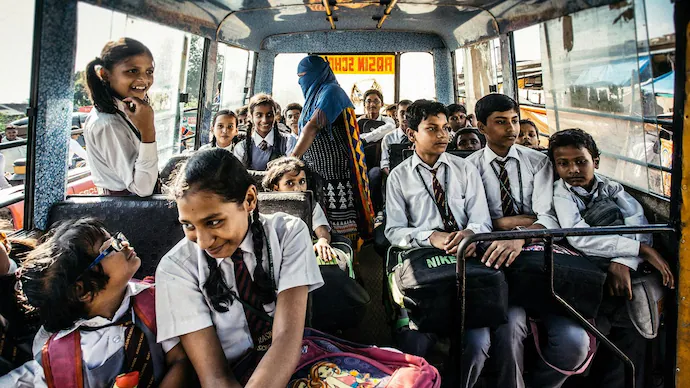- Courses
- GS Full Course 1 Year
- GS Full Course 2 Year
- GS Full Course 3 Year
- GS Full Course Till Selection
- Answer Alpha: Mains 2025 Mentorship
- MEP (Mains Enrichment Programme) Data, Facts
- Essay Target – 150+ Marks
- Online Program
- GS Recorded Course
- Polity
- Geography
- Economy
- Ancient, Medieval and Art & Culture AMAC
- Modern India, Post Independence & World History
- Environment
- Governance
- Science & Technology
- International Relations and Internal Security
- Disaster Management
- Ethics
- NCERT Current Affairs
- Indian Society and Social Issue
- NCERT- Science and Technology
- NCERT - Geography
- NCERT - Ancient History
- NCERT- World History
- NCERT Modern History
- NCERT Medieval History
- CSAT
- 5 LAYERED ARJUNA Mentorship
- Public Administration Optional
- ABOUT US
- OUR TOPPERS
- TEST SERIES
- FREE STUDY MATERIAL
- VIDEOS
- CONTACT US
SC Allows for Sub-Classification of SCs and STs
SC Allows for Sub-Classification of SCs and STs

Background:
The Supreme Court of India recently delivered a landmark verdict allowing states to sub-classify reserved category groups, specifically Scheduled Castes (SCs) and Scheduled Tribes (STs), for the purpose of reservations. This 6-1 majority decision overturns the 2004 ruling in E.V. Chinnaiah vs. State of Andhra Pradesh, marking a significant shift in India's reservation policies.
Key Points of the Verdict
- Sub-classification Permitted:
- States are now constitutionally allowed to sub-classify SCs and STs based on varying levels of backwardness.
- This applies within the existing 15% reservation quota for SCs.
- The aim is to provide better support for the most disadvantaged groups within these categories.
- Distinction Between Sub-classification and Sub-categorization:
- The Chief Justice of India emphasized the difference between these terms.
- Caution was advised against using these classifications for political appeasement rather than genuine upliftment.
- Basis for Sub-classification:
- Must be founded on empirical data and historical evidence of systemic discrimination.
- Arbitrary or political reasons are not acceptable grounds for sub-classification.
- Limitations and Safeguards:
- 100% reservation for any sub-class is not permissible.
- State decisions on sub-classification are subject to judicial review to prevent misuse.
- Application of 'Creamy Layer' Principle:
- The 'creamy layer' concept, previously applied only to Other Backward Classes (OBCs), is now extended to SCs and STs.
- States must identify and exclude the creamy layer within SCs and STs from reservation benefits.
- Generational Limit on Reservations:
- Reservation benefits are to be limited to the first generation only.
- If any generation in a family has benefited from reservations and achieved a higher status, subsequent generations would not be eligible for reservation benefits.
Rationale Behind the Verdict
- Addressing Systemic Discrimination:
- The Court acknowledged that systemic discrimination prevents some members of SCs and STs from advancing.
- Sub-classification under Article 14 of the Constitution can help address these disparities.
- Approach:
- This ruling allows states to create more nuanced reservation policies.
- The aim is to more effectively support the most disadvantaged within these groups.
Historical Context and Legal Journey
- E.V. Chinnaiah Judgment (2004):
- Previously held that SCs formed a homogeneous group and could not be sub-classified.
- This new verdict overturns this precedent.
- State of Punjab v. Davinder Singh (2020):
- A five-judge bench initiated the reconsideration of the E.V. Chinnaiah judgment.
- This case led to the referral of the sub-classification issue to a seven-judge bench.
- Punjab Scheduled Caste and Backward Classes Act (2006):
- Section 4(5) of this Act was a key point of contention.
- It mandated 50% of SC-reserved vacancies in direct recruitment for Balmikis and Mazhabi Sikhs.
- Punjab and Haryana High Court Ruling (2010):
- Struck down the provision of the Punjab Act.
- Relied on the E.V. Chinnaiah judgment, considering all SC castes as one homogeneous group.
Arguments For and Against Sub-classification:
|
Arguments in Favor: |
Arguments Against |
|
|
Significance of the Verdict
- Overturning Previous Precedent: Reverses the E.V. Chinnaiah ruling, allowing for a more nuanced approach to reservations.
- Impact on State Laws: Upholds various state laws that were previously struck down, such as those in Punjab and Tamil Nadu.
- Reshaping Reservation Policies: Opens the door for states to implement more targeted and potentially effective reservation strategies.
Challenges in Implementing Sub-classification
- Data Collection and Evidence:
- Need for accurate, comprehensive socio-economic data on sub-groups.
- Ensuring data accuracy and avoiding biases in collection and interpretation.
- Balancing Interests:
- Complexity in uplifting the most disadvantaged while managing competing interests.
- Uniformity vs. Diversity:
- Striking a balance between tailored local policies and maintaining some level of national uniformity.
- Political Resistance:
- Potential opposition from various political groups, leading to delays or conflicts.
- Social Tensions:
- Risk of exacerbating intra-community conflicts and divisions.
- Administrative Burden:
- Additional resources and manpower required for creating and managing sub-categories.
Forward looking approach :
- Comprehensive Data Collection:
- Leverage the upcoming Census for detailed SC/ST sub-group information.
- Establish independent data verification processes.
- Clear Criteria for Sub-classification:
- Define objective criteria based on socio-economic indicators.
- Avoid subjective or politically motivated decisions.
- Continuous Monitoring and Adjustment:
- Regularly assess the impact of sub-classification policies.
- Ensure benefits reach the intended beneficiaries.
- Long-term Vision:
- Treat sub-classification as a temporary measure to address historical disadvantages.
- Focus on overall socio-economic development and empowerment of SCs and STs.
- Gradually reduce reliance on reservations as broader conditions improve.
- Inclusive Decision-making:
- Involve representatives from various SC/ST sub-groups in policy formulation.
- Ensure transparency in the sub-classification process.
- Education and Awareness:
- Conduct awareness campaigns to explain the rationale and implementation of sub-classification.
- Address misconceptions and alleviate concerns within communities.
This Supreme Court verdict marks a significant shift in India's approach to reservations, aiming to create a more nuanced and effective system. While it presents opportunities for targeted development, it also brings challenges that will require careful navigation by policymakers, administrators, and communities alike.
Must Check: Best IAS Coaching In Delhi
UPSC Prelims Result 2024 Out: Expected Cut Off & Other Details, UPSC Prelims 2024 Answer with Explanation, Daily Prelims Quiz, Daily Current Affairs, MONTHLY CURRENT AFFAIRS TOTAL (CAT) MAGAZINE, Best IAS Coaching Institute in Karol Bagh, Best IAS Coaching Institute in Delhi, Daily Mains Question Answer Practice, ENSURE IAS UPSC Toppers, UPSC Toppers Marksheet, Previous Year Interview Questions, UPSC Syllabus




